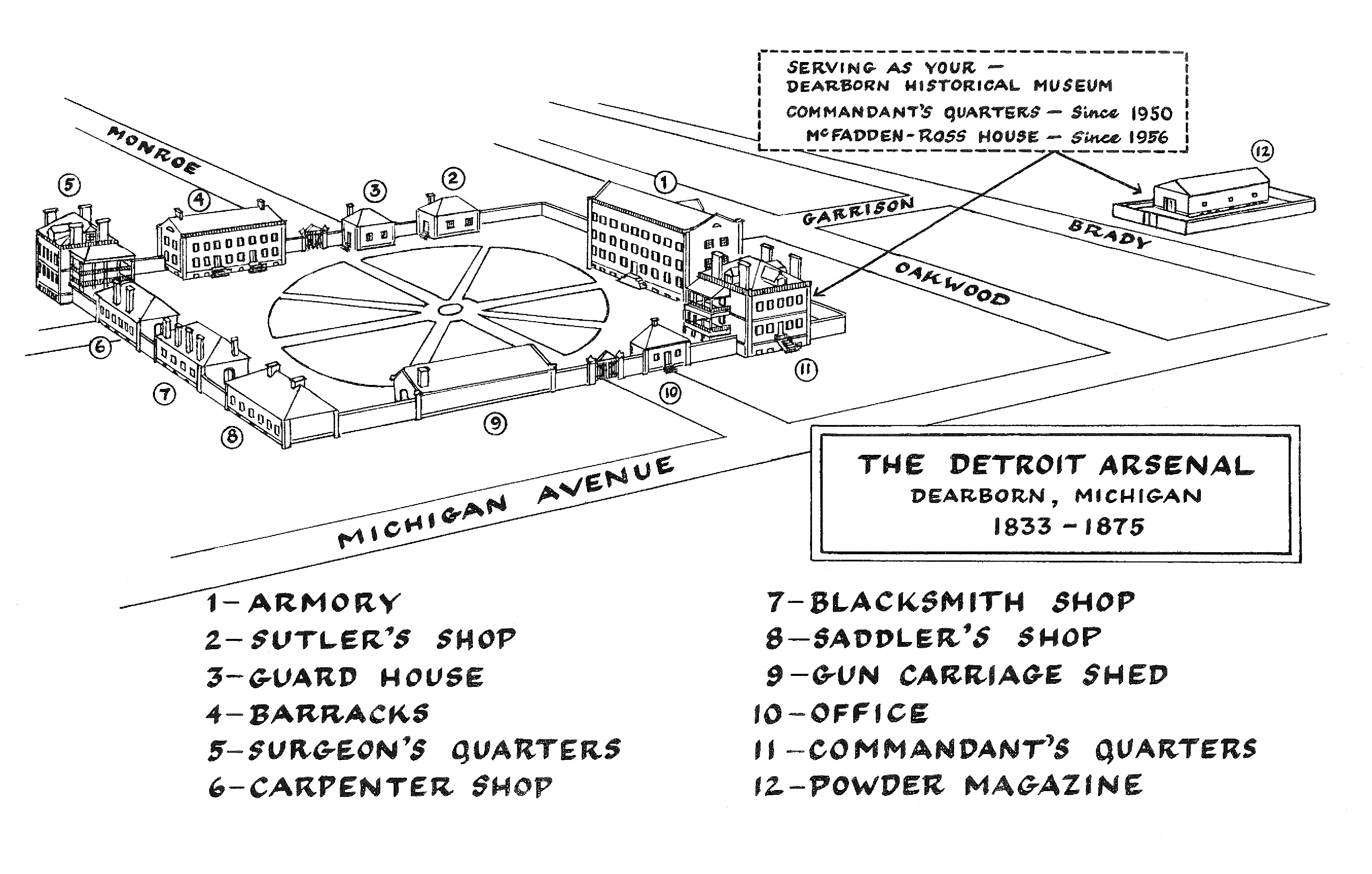In 1832, the rapid growth of Detroit necessitated that the United States military relocate the Detroit Arsenal–a complex for storing and repairing weapons and munitions–outside of Detroit. A small, sparsely-populated area outside of Detroit was chosen as the new home for the Arsenal and came to be known as Dearbornville in honor of Revolutionary War hero General Henry Dearborn under the command of the Arsenal’s first commandant, Colonel Joshua Howard.
The Arsenal was not a defensive fortification, nor was it a small installation. It was comprised of eleven buildings and a large parade ground which was surrounded by a brick wall and gates. To the east of the Arsenal stood the powder magazine. This one story building, with walls four feet thick, was used as a storehouse for gunpowder and explosive ammunition. The magazine was located away from the Arsenal complex on what is now known as Brady Street. The location was chosen to prevent an explosion within the magazine from destroying the entire Arsenal. Below the magazine, on the Rouge River, there was a dock (Thompson’s), which was used during high water to bring heavy loads to the magazine and Arsenal.
Surrounding the Arsenal Installation was the United States Military Reserve. This was comprised of vast amounts of land, containing lumber, grasslands and water. The trees were very important as they were used for the building of the Arsenal, for gun carriages, ships, and any other needs of the military. To the north of the Arsenal on the flood plain of the Rouge River were the stables, barns and pasture. This northern area covered Ford Field and a little beyond.
In 1864, the Arsenal was under the command of Mr. Charles Wilking. He was a Military Storekeeper, on active duty from the Ordnance Department of the United States Army. Mr. Wilkins was a civilian and had no official military rank. He was paid at the same rate of an Army Captain. He was allowed all of the privileges due that rank with the exception of being saluted.
Within the walls of this post, there were eight men of the Ordnance Department on duty. Six were Privates, one a Corporal and one Sergeant of Ordnance. The Sergeant’s name was John S. Cosbey. He had been stationed at the arsenal for many years, rising in the ranks from Private, Second Class to that of Sergeant. His duties included keeping track of all weapons currently stored at the Arsenal, as well as receiving and reconditioning used weapons from units mustering out of service. The Sergeant had to catalog and store each and every weapon at the Arsenal, from Cavalry swords to artillery pieces.

Also serving at the Arsenal under the command of Captain George Davenport were members of Company F, Second Regiment, Veteran Reserve Corps. The Veteran Reserves were soldiers who had been wounded in combat, or were ill, and are no longer fit for front line duty. They were noticeable because of their light blue uniforms, as opposed to the dark blue uniforms of the Army regulars. The Veteran Reserves had been sent to the Arsenal to perform guard duty and to escort supply wagons from the Arsenal to units in the field.
Sometimes troops, such as the 21st Michigan, came to the Arsenal on their way to another outpost. The 21st Troops came to acquire ammunition and other ordnance supplies and would bivouac the night within the military reserve. The Army Surgeon, present at the Arsenal, would also treat some of the wounded of the 21st, who had been brought there for proper medical attention. Dr. Edward Snow, acting Army Surgeon of the Detroit Arsenal, was also on duty to assist the Medical Officer. Dr. Snow was a leading citizen of Dearbornville, and was well respected as an excellent surgeon and physician.
This U. S. Army ordnance facility was constructed here to supply the “Old Northwest” territory. By 1864, the frontier was moving west and by 1875, the Arsenal was no longer needed. It was sold to private citizens, and served the community in many ways. Before becoming a part of the Museum, the Commandant’s Quarters was used as a police station, a kindergarten, and a village hall. The Arsenal’s Armory was converted into a clothing factory known as Arna Mills until it was destroyed in a fire in 1910. The Second Officers’ Quarters was replaced with Adams Junior High and the Salisbury School Training Center. Finally the Smith’s and Carpenter’s shops were converted into parts of Dearborn’s early auto manufacturing industry. A lot of the less-prominent buildings have now been made into parking lots.
Currently there are four of the original buildings in existence. The Commandant’s Quarters, the restored museum building at Michigan Avenue and Monroe Street, the gun carriage shop, which is now Cannoli Bakery on Monroe Street, the Sutler’s Shop, which is part of a medical building on Garrison Street, and the Powder Magazine, which was remodeled for a home, known as the McFadden-Ross house on Brady Street. This home is also part of our museum campus, and currently houses some staff offices, meeting facilities and display rooms.

